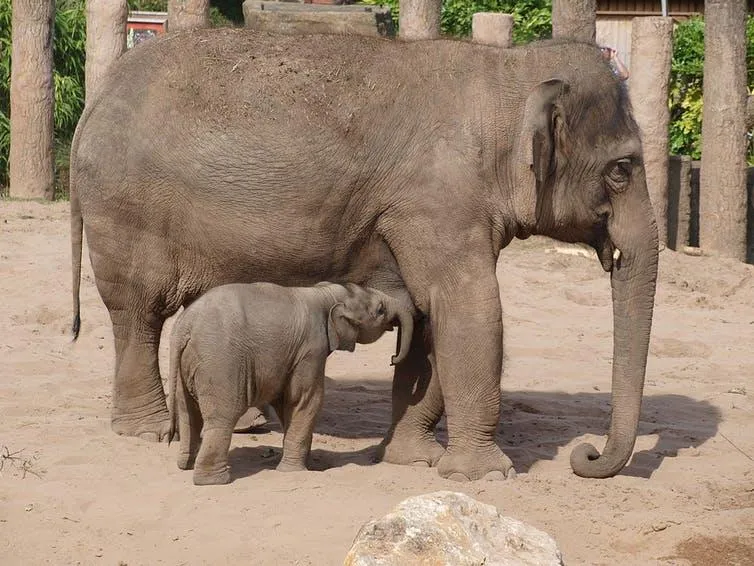How Long Does It Take For A Small Animal To Start Smelling After Death
/https://tf-cmsv2-smithsonianmag-media.s3.amazonaws.com/filer/12/f8/12f8d9c8-91f3-473d-88b7-a6961ec96f75/file-20180821-149496-3ecos6.jpg)
For many weeks, news of a mother orca carrying her dead babe through the icy waters of the Salish Ocean captured the attention of many around the world. Keeping the infant afloat equally best she could, the orca, named Tahlequah, also known as J35 by scientists, persisted for 17 days, before finally dropping the dead dogie.
This has been one of the most protracted displays of marine mammal grieving.
Among scientists, however, there remains a prejudice against the idea that animals feel "real" grief or respond in complex ways to death. Following reports of the "grieving," zoologist Jules Howard, for example, wrote, "If you believe J35 was displaying evidence of mourning or grief, yous are making a case that rests on faith, not on scientific endeavor."
As a bioethicist, I've been studying the interplay between science and ideals for more than two decades. A growing torso of scientific evidence supports the thought that nonhuman animals are enlightened of decease, tin experience grief and volition sometimes mourn for or ritualize their expressionless.
You tin't see when you don't expect
Animate being grief skeptics are correct about one thing: Scientists don't know all that much about death-related behaviors such as grief in nonhuman animals. Only a few scholars have explored how the multitude of creatures with whom humans share the planet think and experience about decease, either their own or others'.
But, I argue, that they don't know because they haven't looked.
Scientists oasis't yet turned serious attention to the study of what might exist chosen "comparative thanatology" – the study of expiry and the practices associated with it. This is perhaps because almost humans failed to even entertain the possibility that animals might care nigh the decease of those they love.
Sensation of mortality has remained, for many scientists and philosophers alike, a bastion of human-perceived uniqueness.
Creature grief

Nevertheless, a growing collection of anecdotal reports of grieving and other death-related behaviors in a broad range of species is helping researchers frame questions about expiry awareness in animals and figure out how best to written report these behaviors.
Elephants, for case, are known to take a great interest in the bones of their deceased and to mourn for dead relatives. One of these vivid ritual explorations of basic was defenseless on video in 2016 by a doctoral student studying elephants in Africa. Members of iii different elephant families came to visit the torso of a deceased dame, smelling and touching and repeatedly passing past the corpse.
Chimpanzees have besides been repeatedly observed engaging in death-related behaviors. In one case, a small-scale grouping of captive chimpanzees was carefully observed after one of their members, an elderly female named Pansy, died. The chimpanzees checked Pansy'due south body for signs of life and cleaned bits of straw from her fur. They refused to go to the place where Pansy had died for several days subsequently.
In some other case, scientists documented a chimpanzee using a tool to clean a corpse. In 2017, a squad of primate researchers in Zambia filmed a mother using a piece of dried grass to clean debris from the teeth of her deceased son. The implication, co-ordinate to the scientists involved, is that chimpanzees keep to experience social bonds, fifty-fifty after death, and feel some sensitivity toward dead bodies.
Magpies take been observed burying their dead under twigs of grass. Ethologist Marc Bekoff, who observed this behavior, described it every bit a "magpie funeral."
In i of the most fascinating contempo examples, an 8-twelvemonth-old boy caught video footage of peccaries, a species of wild pig-like animal found in parts of the U.S., responding to a dead herd-mate. The peccaries visited the dead body repeatedly, nuzzling it and bitter at it, as well as sleeping next to information technology.
Crows have been seen forming what scientists call "cacophonous aggregations" – mobbing and squawking in a big group – in response to another expressionless crow.
These are just a few of the many examples. (For a couple of additional videos, click here and here.)
Some scientists insist that behaviors such of these shouldn't be labeled with human terms such every bit "grief" and "mourning" because it isn't rigorous scientific discipline. Science can discover a given behavior, simply it is very difficult to know what feeling has motivated that behavior. A 2011 written report published in Science that found testify of empathy in rats and mice was met with a similar kind of skepticism.
It's about how animals grieve
I hold that a large degree of circumspection is appropriate when it comes to ascribing emotions and behaviors such equally grief to animals. Only non because at that place is any doubtfulness that animals feel or grieve, or that a mother's anguish over the loss of her child is any less painful.
The case of Tahlequah shows that humans have a great deal to learn about other animals. The question is not "Exercise animals grieve?" but "How practise animals grieve?"
This article was originally published on The Conversation. ![]()
Jessica Pierce, Professor of Bioethics, University of Colorado Denver
Source: https://www.smithsonianmag.com/science-nature/do-animals-experience-grief-180970124/
Posted by: stanleythistried.blogspot.com

0 Response to "How Long Does It Take For A Small Animal To Start Smelling After Death"
Post a Comment